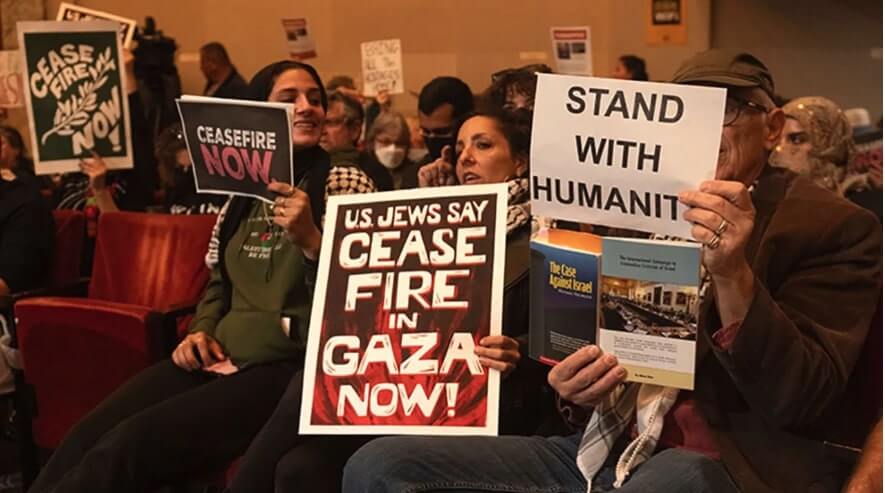Could Merging Hebrew And Arabic Alphabets Help Bring Peace To Middle East?

Image by Facebook
TEL AVIV (JTA) — Middle East peace may remain out of reach, but at least the Hebrew and Arabic languages have found a compromise.
Israeli typography designer Liron Lavi Turkenich has created a stylized writing system that merges the two ancient alphabets, allowing Hebrew and Arabic speakers to read the same words. Her hope is that Aravrit will promote coexistence in Israel and beyond.
“I believe Aravrit sends a message that we’re both here, and we might as well acknowledge each other,” Turkenich told JTA. “That applies to Jews and Arab Israelis, but also to Israel and the Palestinians and Israel and the Arab world.”
Israelis have been receptive. Over 1 million people have watched a Hebrew-language video introducing Aravrit since it was posted last week on Facebook by Kan, Israel’s new broadcasting authority. Dozens left positive comments. A version of the video with English subtitles was released Monday.
“I think maybe this explains the crazy success of the Hebrew video: We can do something caring for the other side just by reading, without having a solution,” Turkenich said.
Turkenich, 32, was inspired to create Aravrit by the road signs in Haifa, the mixed Jewish and Arab city where she was born and has lived most of her life. Although many of the signs feature Arabic — along with Hebrew and English — she realized that she had always ignored the lettering. Arabic tends to appear smaller on official signage and, like most Israeli Jews, she cannot read it.
For her final undergraduate project, Turkenich set out to combine Hebrew and Arabic lettering in a way that would allow them to “live together,” as she put it. She started by revisiting the work of French ophthalmologist Louis Émile Javal, who in the late 19th century found that people can read pretty well using only the top half of Latin letters. With some experimenting, Turkenich discovered that the same is true of Arabic — and by happy coincidence, the opposite holds for Hebrew.
“In Hebrew, most of the identifying characteristics of letters’ forms are near the bottom part,” she said. “When I went to check Arabic, I crossed my fingers that they would be on the top half — and they were!”
Based on this insight, Turkenich combined each of the 22 letters in Hebrew with each of the 29 in Arabic to create an Aravrit alphabet with 638 characters. Vowels are used as needed for legibility — below the Hebrew letters and above the Arabic ones, per the languages’ respective rules. Turkenich tested the Hebrew elements on herself and her friends. For advice on the Arabic, she turned to Arab-Israeli commuters on her daily train ride from Haifa to Tel Aviv.
“Whenever I heard someone speaking Arabic, I would ask them if they had time to answer a few questions. They always said yes,” she recalled, noting that she now has Arab friends who help.
Since graduating in 2012 from Shenkar, a college of engineering, design and art in Ramat Gan, Turkenich has further developed Aravit into a writing system. She has incorporated alternative forms of letters in both languages — some Hebrew letters take on a different form at the end of words — and connected the Arabic elements in traditional cursive style. The changes have given her the flexibility to craft each word in a unique way, and she is working on writing down the rules.
Turkenich said she gets lots of requests to write Aravrit, including recently from the head of a small mostly Jewish city in Israel that she declined to name. She also teaches and gives lectures about her work in Israel and around the world. Last year, Aravrit was exhibited at The Museum of Islamic and Near Eastern Cultures in Beersheba.
Language of course can be a political issue in the Jewish state. Hebrew and Arabic both have sacred roots, and are central to the identities at stake in the Arab-Israeli-Palestinian conflict. Earlier this month, Israeli ministers backed a bill that would constitutionally enshrine the country’s Jewish status and make Hebrew the only official language, demoting Arabic from that status — and, critics say, further marginalizing the 20 percent of Israelis who are Arab.
But Turkenich said her goal is to build on the languages, not subvert them. In Aravrit — itself a hybrid of the Hebrew words for Arabic and Hebrew — sentences follow the grammar rules of Arabic on top and Hebrew on the bottom, she noted, and the lettering retains the most prominent features of each script. A word like “peace,” for example, would read as “salaam” on top and “shalom” on bottom.
“Both Hebrew and Arabic have incredible histories. We should not erase them,” she said. “It’s the same as the political situation: We can’t start from scratch.”
Arabs are not the only Israeli minority group Turkenich is interested in. While earning a master’s degree in typeface design from England’s University of Reading in 2015, she developed a typeface called Makeda, the name Ethiopians use for the Queen of Sheba, which works for Amharic, Hebrew and Latin letters. She hopes it will be used for Israeli government and legal documents relevant to the country’s 135,000 Ethiopian Jews.
“Makeda is a little less idealistic than Aravrit,” Turkenich said, laughing. “That was me growing up.”
The Forward is free to read, but it isn’t free to produce

I hope you appreciated this article. Before you go, I’d like to ask you to please support the Forward.
Now more than ever, American Jews need independent news they can trust, with reporting driven by truth, not ideology. We serve you, not any ideological agenda.
At a time when other newsrooms are closing or cutting back, the Forward has removed its paywall and invested additional resources to report on the ground from Israel and around the U.S. on the impact of the war, rising antisemitism and polarized discourse.
This is a great time to support independent Jewish journalism you rely on. Make a gift today!
— Rachel Fishman Feddersen, Publisher and CEO
Support our mission to tell the Jewish story fully and fairly.
Most Popular
- 1

Fast Forward Ye debuts ‘Heil Hitler’ music video that includes a sample of a Hitler speech
- 2

Opinion It looks like Israel totally underestimated Trump
- 3

Culture Cardinals are Catholic, not Jewish — so why do they all wear yarmulkes?
- 4

Fast Forward Student suspended for ‘F— the Jews’ video defends himself on antisemitic podcast
In Case You Missed It
-

Culture How one Jewish woman fought the Nazis — and helped found a new Italian republic
-

Opinion It looks like Israel totally underestimated Trump
-

Fast Forward Betar ‘almost exclusively triggered’ former student’s detention, judge says
-

Fast Forward ‘Honey, he’s had enough of you’: Trump’s Middle East moves increasingly appear to sideline Israel
-
Shop the Forward Store
100% of profits support our journalism
Republish This Story
Please read before republishing
We’re happy to make this story available to republish for free, unless it originated with JTA, Haaretz or another publication (as indicated on the article) and as long as you follow our guidelines.
You must comply with the following:
- Credit the Forward
- Retain our pixel
- Preserve our canonical link in Google search
- Add a noindex tag in Google search
See our full guidelines for more information, and this guide for detail about canonical URLs.
To republish, copy the HTML by clicking on the yellow button to the right; it includes our tracking pixel, all paragraph styles and hyperlinks, the author byline and credit to the Forward. It does not include images; to avoid copyright violations, you must add them manually, following our guidelines. Please email us at [email protected], subject line “republish,” with any questions or to let us know what stories you’re picking up.















